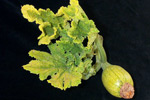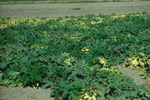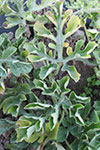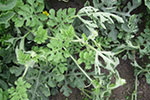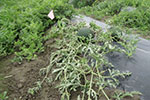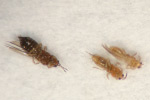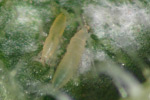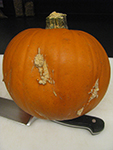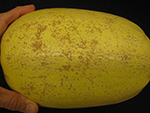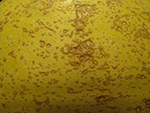Photo Gallery of Vegetable Problems
Watermelon
(Click on photo to enlarge)
Diseases
Disease: Curly top
Pathogen: Various strains of Beet curly top virus (BCTV), which are vectored by the beet leafhopper (Circulifer tenellus)
Host crops: Numerous plant species including many vegetables such as bean, beet, carrot, eggplant, coriander, pepper, potato, tomato, various cucurbits such as squash, cucumber, pumpkin, watermelon, etc.
On-Line Resources:
Pacific Northwest Plant Disease Management Handbook: Squash (Cucurbita spp.) – Curly Top
Disease: Damping-off/Seedling blight
Pathogen: Pythium
Host crops: Most vegetables are susceptible to damping-off/seedling blight.
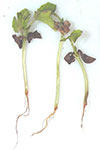 |
| Photo Source: Lindsey du Toit |
On-Line Resources:
Pacific Northwest Plant Disease Management Handbook: Watermelon (Citrullus lanatus) – Damping-off
See Diseases, pests, and other problems common to many vegetables: Damping-off/seedling blight.
Disease: Verticillium wilt
Pathogen: Verticillium species
Host crops: Numerous vegetables including many brassica vegetables (but not broccoli), cucumber, eggplant, pepper, potato, pumpkin, radish, spinach, tomato, watermelon, etc.
On-Line Resources:
Pacific Northwest Plant Disease Management Handbook: Watermelon (Citrullus sp.) – Verticillium Wilt
See Diseases, pests, and other problems common to many vegetables: Verticillium Wilt.
Insect/Mite Pests
Common name: Western flower thrips
Latin binomial: Frankliniella occidentalis.
Host crops: Basil, Broccoli, Cabbage, Cauliflower, Cucumber, Onion, Potato, Pumpkin, Squash, Tomato and Watermelon.
On-Line Resources:
Western Flower Thrips Thysanoptera: Thripidae Frankiniella occidentalis,
Cucurbits: Thrips, UC IPM Online, University of California
See Diseases, pests, and other problems common to many vegetables: Western flower thrips.
Abiotic Problems
Problem: Edema
A physiological problem: prominent when air is cooler than the soil, soil moisture is high, and relative humidity is high. The low plant transpiration rates combined with an increase in water absorption by roots from the soil leads to increased cell turgor pressure, resulting in eruption of epidermal cells as the inner cells enlarge. Protrusion of the inner cells causes epidermal cells to die and discolor, resulting in a ’warty’ appearance that can be misidentified as a disease. In addition to foliar symptoms on some hosts, many cucurbit crops develop wart-like protruberances on the fruit.
On-Line Resources:
https://www.omafra.gov.on.ca/english/crops/facts/00-031.htm#oedema
Our pages provide links to external sites for the convenience of users. WSU Extension does not manage these external sites, nor does Extension review, control, or take responsibility for the content of these sites. These external sites do not implicitly or explicitly represent official positions and policies of WSU Extension.

